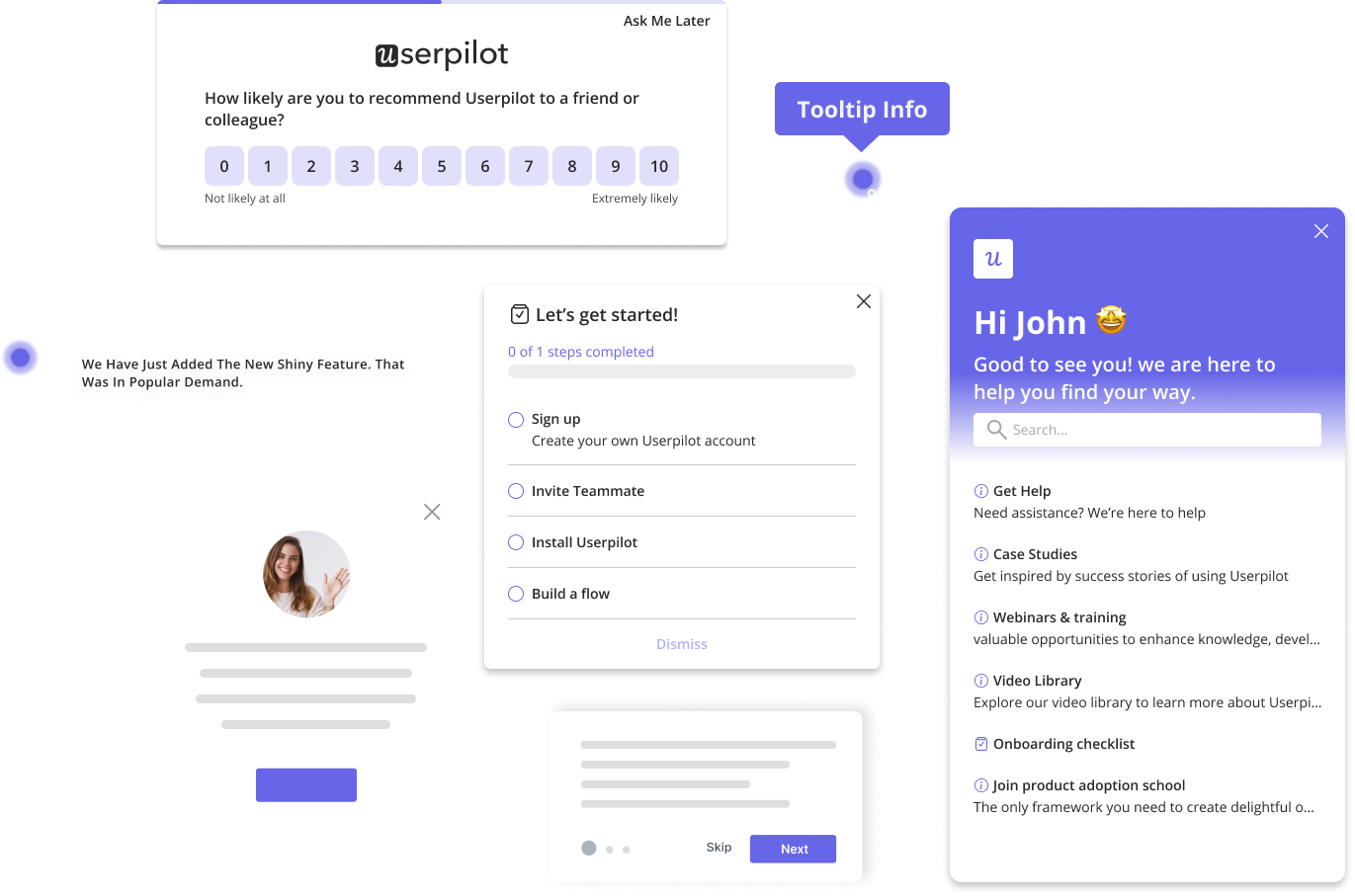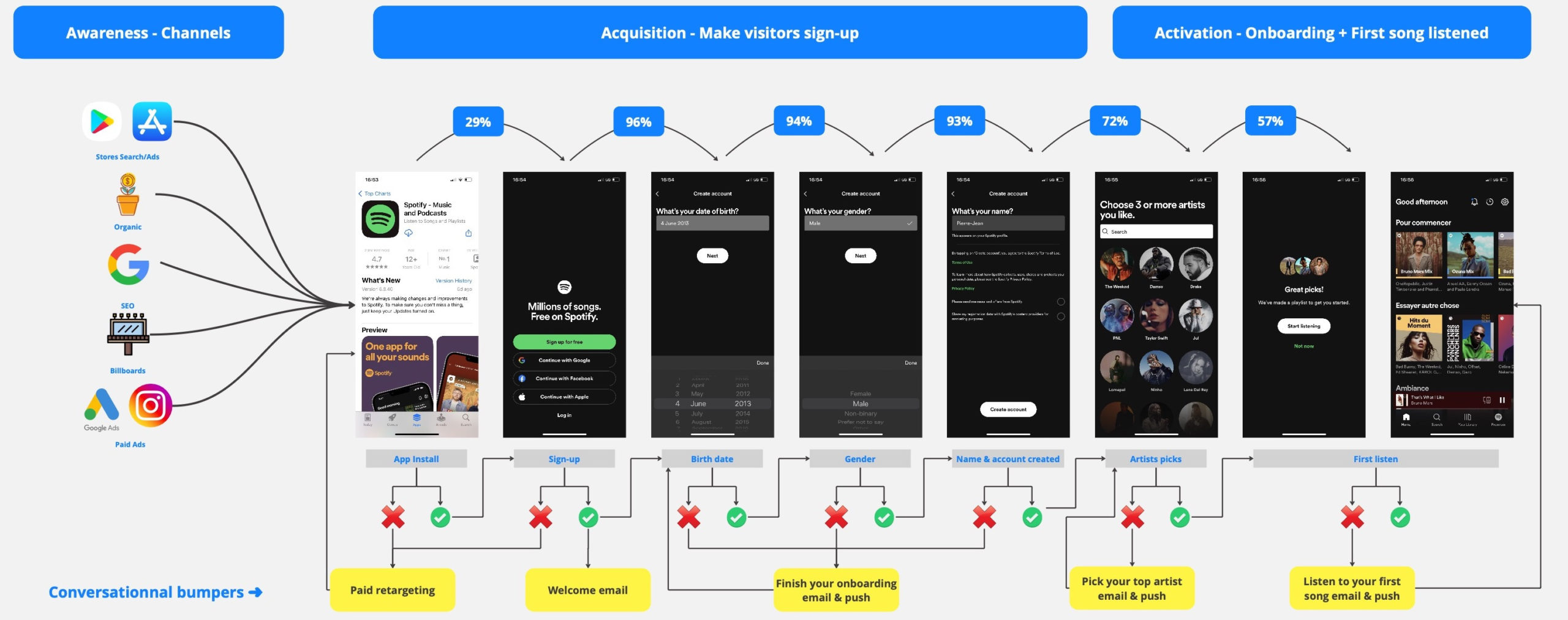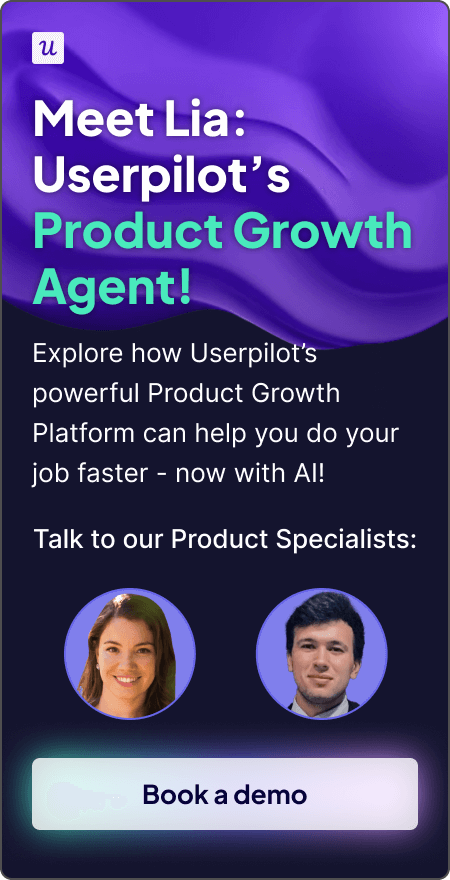The 3-Step Process to Improve Awareness to Activation Funnel Conversion in Mobile Apps
Getting users to discover your mobile app is only half the battle. The real challenge is guiding them toward activation. If users drop off before experiencing your product’s value, your acquisition efforts go to waste.
To bridge this gap, here’s my 3-step process to improve your funnel conversion, from awareness to activation:
- 👀 Map your user journey: Map the steps your users should go through from discovering your product (awareness) to experiencing its value (activation). This process starts by listing your main acquisition channels and ends with the activation moment. The purpose is to help you visualize your journey to optimize it.
- 📊 Analyze conversion and identify bottlenecks: Once your mapping is done, analyze the conversion between each step to identify the main drop-offs. They can be due to poor UX, complexity in using the product, or an unclear value prop. User research will help you understand why your users drop at these steps.
- 📈 Identify growth levers to increase funnel conversion: Focus on improving the conversion of the main bottlenecks. That’s where you’ll have the most area to grow. CRO tactics like educational content, CRM communications, social proof, or personalization can help you to drastically improve conversion.
👉🏻 Bonus at the end of the article: Catch my Miro template to map your user journey.
Try Userpilot Now
See Why 1,000+ Teams Choose Userpilot
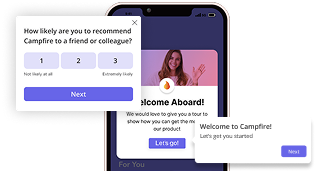
Understanding the 3-step process in detail
1. Map your user journey from awareness to activation
When users discover your product, your goal is to make them experience its value. But before that, they need to go through several steps. Our objective here is to map this path.
In growth, many people stop optimizing once acquisition has been reached, thinking their job is finished. But having a full-funnel vision is what will drive powerful and sustainable growth. Users’ life is just about to start when they reach acquisition.
Without a clear visualization of the steps your users must complete to experience your product, you’re totally blind and unable to improve conversion over your funnel. But, with a clear view of your user journey, you’ll have the keys to improve conversion.
→ That’s why mapping your user journey, from awareness to activation, is key. It’s the foundation to identify bottlenecks and then growth opportunities.
To start our user journey mapping, we can decompose the user journey into 3 main phases:
- Awareness: How do users discover your brand? What are your acquisition channels?
- Acquisition: Where do your users land (website, landing page, app store)? What do they need to do to use your product (sign-up, book a demo)?
- Activation: How do they onboard with your product and experience its value?
Answering those questions is the foundation to build your journey.
Mapping out the user journey, step by step within each phase, will help you visualize the entire process effectively. I recommend using a funnel view for the user journey: it’s the best visualization for mapping a process to go from one step to the other.
Although most users may not follow every step in a linear sequence, your goal is to guide them from point A to point B.
Let’s look at a concrete user journey mapping example for the Spotify mobile app:
Awareness: People discover your product
Through different channels (app store search/ads, organic, SEO, paid ads, billboards, etc.), people discover Spotify. This stage of awareness is key, as it’s when people first hear about the product.
Acquisition: Turn visitors into users
As Spotify’s goal is to make users sign up for their app, acquisition channels redirect users to the Spotify app store page. Users go through some sub-steps to be fully acquired:
- Install the app.
- Start sign-up.
- Add birth date.
- Add gender.
- Add name and finish sign-up.
For a service, the acquisition stage will be different: people will likely land on a website and fill out a form or book a call to be considered as acquired.
Activation: Make users experience the value of your product
On Spotify, users need to listen to their first song to discover the value of the product. The process is pretty simple:
- Pick 3 artists you like.
- Start listening to your first song.
- Enjoy the product features (playlists, smart recommendations, etc.).
Spotify has reduced the steps to the very minimum to make the user experience as simple as possible. And having mapped the user journey, we are able to see it.
2. Analyze conversion and identify bottlenecks
Now that we’ve mapped our funnel, it’s time to analyze the conversion between each step and identify bottlenecks. But also to understand why drop-offs happen.
This analysis will help find levers to improve growth, the 3rd step of our process.
Analyze conversion between each step of the funnel to identify bottlenecks:
- What are the steps where you lose a large percentage of users? The goal here is to identify the 2 or 3 steps where there is a big room for improvement.
- Does it seem “normal” to lose many users at these steps? For example, losing 50% of users during onboarding is probably too much. There is an opportunity to gain some conversion points.
- It’s important to look at industry/competitors’ benchmarks to understand how you’re doing.
Identifying the steps where you could lose fewer users will help to prioritize levers and experimentations to better convert.
Key conversion rate metrics to look at:
- Website main conversion rate: % of visitors who sign-up/book a demo.
- Onboarding completion rate: % of users completing the onboarding.
- Activation rate: % of users reaching the activation moment.
In our Spotify user journey mapping example, we now added conversion rates between each step of the funnel.
The figures below are fake and were added for the sake of the example.
We clearly see 3 big bottlenecks:
- App install to sign-up (29%).
- Account created to artists’ picks (72%).
- Artists’ picks to first listen (57%).
That’s probably where we have the most chances to gain conversion improvements. The other conversion rates are already really high, so I would focus on the three steps mentioned above.
Understand why users drop-off: 3 main reasons:
- Lack of clarity on the value proposition: Your user does not understand what the value of your product is. This can occur on your website or product, and can then impact website conversion as well as onboarding and activation. If your users don’t understand your value proposition, they’ll lack the necessary motivation to complete onboarding.
- Confusing UX: Your user doesn’t know what they need to do to experience your product. As for the value proposition, a confusing UX can happen on your website or during the onboarding.
- Complex onboarding processes: Your user loses motivation to complete the onboarding as the process is too long or complicated.
Doing user research, paired with product analysis, will bring you the necessary insights to understand if one (or more) of the three reasons above impact your funnel conversion.
→ This step of understanding why users drop is crucial, as it will strongly impact the growth levers you should choose to improve conversion.
3. Identify growth levers to increase funnel conversion
Here comes the last step of our process. You should now have:
- A clear view of the steps of your funnel.
- Identified bottlenecks that can be turned into growth opportunities.
To improve conversion, you have two main options:
- Improve existing conversion levers.
- Create from scratch new levers.
Those levers can be either outside or in-product.
At this step, I recommend adding to your map the existing communications you already send to your users → the conversational bumpers. The purpose of doing this is to see what you already do to increase conversion.
In our Spotify user journey map example, we can imagine that Spotify added the following conversational levers (yellow boxes) to improve conversion:
The whole picture is now painted. It’s time to determine the levers we want to activate.
Many levers exist, but I found 10 techniques that are proven to be particularly efficient. Depending on the results of your user research about why users drop off at certain steps of the funnel, you should now have insights to understand which lever you can activate.
10 CRO techniques to increase conversion
📣 Value proposition iterations
Iterating on value proposition and the wording across your entire funnel is easy from a technical point of view, but can lead to great conversion uplifts.
You need to ensure that users understand the benefits of using your product. It’s also very important to have a coherent value proposition all over your funnel: that’s where having a strong collaboration between marketing (in charge of awareness and acquisition) and product (in charge of activation) is critical.
⌛️ Urgency
Playing on urgency, with limited-time offers or FOMO effects, can be powerful. It’s proven that a sense of urgency incites users to convert more, as they don’t want to miss an offer. This tactic is widely used in the e-commerce industry.
But urgency should be smartly used: if you provide limited offers during a certain period, stick to it. It’s disgraceful to see an “Offer expires in 3 days,” and when you come back one week later on the landing page, the same message and promotion are still there.
So authenticity is key to building sustainable growth when playing with urgency.
⭐️ Social proof
Social proof can be materialized through testimonials, ratings, PR mentions, or even case studies of your biggest customers.
The main objective of social proof is to reassure users that they are currently dealing with a serious company with a proven track record.
I strongly recommend adding social proof both on your main landing pages and during your onboarding by using different formats (testimonials/ratings/PR mentions). It will constantly remind your users why they should trust your product.
💻 Interactive demo
With the rise of product-led growth, adding interactive demos of a product on a landing page is a tactic that is starting to emerge.
If you have a great product that speaks for itself and demonstrates value quickly, allowing your users to see a demo can drastically improve conversion.
🔁 Retargeting
Retargeting users who have visited your website is an old but gold technique. People who already discovered your product are more likely to convert than new visitors; that’s why retargeting them can be very effective.
Consider also retargeting users who did not finish your onboarding: remind them you’re still here.
Triggering push notifications to users who abandon the onboarding process is a quick way to bring them back to the funnel. However, it’s crucial to create messages that are relevant and value-driven rather than generic reminders.
🧑🏫 Educational content
Educating your users on your product can be particularly useful to increase activation. We sometimes forget that our users don’t have the same knowledge of our products as us. Things that look basic for us can be difficult to understand for your users. That’s where educational content comes in.
Educational content can be:
- Video tutorials.
- Blog/help center articles.
- Chatbots.
- Product tours.
Editor’s note: Creating interactive product tours is stress-free with Userpilot. Its WYSIWYG editor lets you build carousels and slideouts for user onboarding – no coding needed. You can also set them to trigger contextually for specific audiences, making the experience even more relevant.
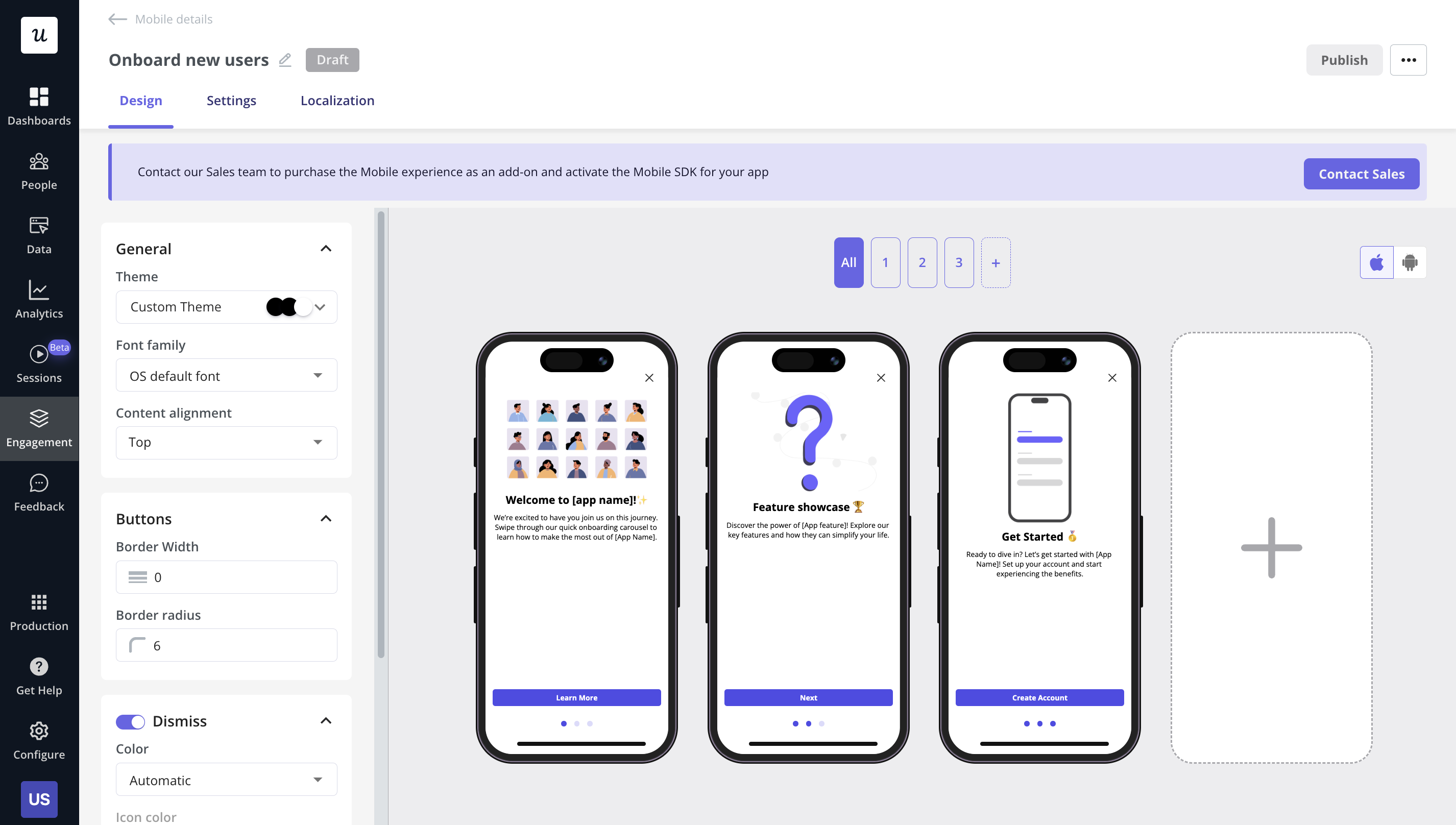
🫵 Personalization
Personalizing a landing page and/or onboarding is a great way to make your users feel special. And make them more likely to convert.
To personalize your landing page/onboarding, you should rely on your own data. With the data gathered, you can personalize, depending on the persona:
- Activation moment.
- Value proposition.
- Onboarding.
🎮 Gamification
Gamification techniques, like rewards, progress bars, or challenges, are great for improving acquisition and activation conversion.
As humans, we all like to play. Make your product enjoyable to use, like a game.
💬 CRM communications
This is a classic technique to move users from one step to the other. Leveraging CRM communications like in-app messages, push notifications, or emails is a powerful way to make users convert. Consider building automated sequences of communications based on user behavior to nurture them and make them engaged.
📞 Calling campaigns
Calling campaigns are underrated. The phone is now an old channel, but can still be very efficient.
To increase activation, you could consider calling your new users to explain to them how to use your product and give them tips to become successful.
I recommend focusing on a specific segment that is already familiar with your product, as a calling campaign is a costly channel.
A final word on improving funnel conversions
By systematically mapping, analyzing, and optimizing the funnel, mobile apps can significantly increase conversion rates and ensure that acquisition efforts translate into engaged, activated users.
To maximize the effectiveness of these optimizations, all techniques should be A/B tested using treatment and control groups to measure their impact accurately.
Bonus 🎁: Want to map your user journey? Steal my Miro template here.
Don’t Miss Out on Expert Knowledge That Keeps You Ahead.



